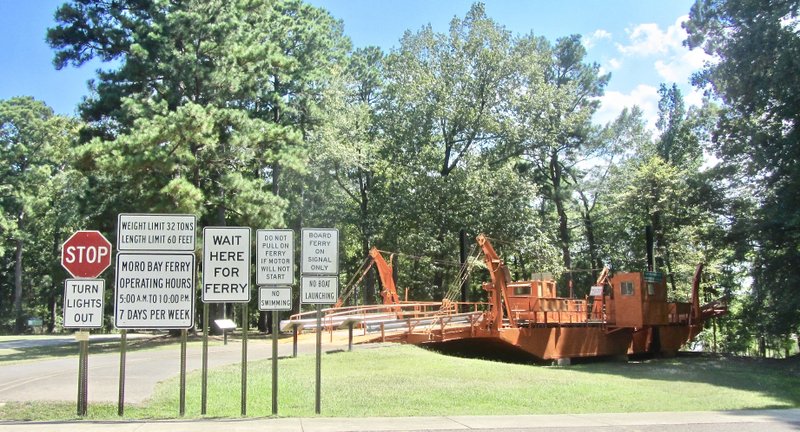MORO BAY STATE PARK — Like a fish out of water, the ferry that once carried traffic across the Ouachita River in Bradley County sits beached as a certified relic in Moro Bay State Park.
Listed last year on the National Register of Historic Places, the retired vessel stands out from surrounding greenery, thanks to its orange color. Nearby signs give visitors a briefing on bygone times when dozens of ferries crossed waterways in Arkansas before extensive bridge-building rendered them obsolete by the last decades of the 20th century.
The state park's brochure describes the lengthy history of Ouachita River crossings at this junction with two other waterways, Raymond Lake and Moro Bay:
"Various private ferries operated intermittently in this vicinity from 1834 to 1947. Bradley County and Union County were isolated by the barrier effect of the Ouachita River, in the absence of all crossing transportation from 1947 to 1965.
"The ferry operation was resumed on April 28, 1965, as a free ferry owned and operated by the Arkansas Highway and Transportation Department. The ferry ceased operation again in 1992 when two bridges were completed over the Ouachita River and Raymond Lake."
The resumption of ferry service was a big enough deal that it was featured in the May 1965 issue of Arkansas Highways Magazine, with the cover photo showing the christening of the craft. To salute Bradley County's most famous product, the bottle broken to celebrate the launch contained the juice of the flavorful local tomatoes. The honors were done by Nancy Herring, that year's Miss Pink Tomato, at the festival in Warren. Dignitaries watching the christening included Gov. Orval E. Faubus.
The Moro Bay Ferry was one of the last four operated by the highway department, which still runs one such free service. It's the Peel Ferry, which crosses a section of Bull Shoals Lake in the state's far north.
Although retired for 27 years, the Moro Bay Ferry can still float if necessary when the Ouachita River floods. Adding to the period flavor are replicas of a dozen road signs that travelers would have seen as they neared the vessel.
One sign mandates that trucks hauling inflammables (with the second "m" missing) or explosives must cross the river with no other vehicles aboard. Another carries a slightly puzzling message: "Do not pull on ferry if motor will not start."
There's an elegiac tone to an informational sign, headlined "End of an Era," about the last crossing on Oct. 27, 1992: "That day the bridge opened to traffic, making it possible for families, businessmen, vacationers, ambulances and 18-wheelers to speed on their way — with no wait for the ferry or a thought of the stories it holds."
Along with its waterborne history, Moro Bay State Park provides an assortment of recreational pleasures. The park's brochure touts "the abundant bass, bream, crappie and catfish found in the many lakes and streams of the area." Two quarter-mile hiking trails make for scenic exercising.
Overnight visitors can stay at one of the 23 campsites. Comfortable family lodging is available at five cabins that feature a screened deck, two bedrooms, two baths and a kitchen. The decks overlook Moro Bay near its junction with the Ouachita River, not far from where the ferry once did the job that bridges now do.
The visitor center at Moro Bay State Park, on Arkansas 600 off U.S. 63 about 22 miles east of El Dorado, is open 8 a.m.-5 p.m. daily. Admission is free. Visit ArkansasStateParks.com or call (870) 463-8555.
Style on 09/17/2019

